Tuesday Nov. 7
Dr. Weidman is out of town because of a family emergency. The
quizzes will be returned when he returns.
An optional assignment handed out in class today will be due at the end
of the
period on Thursday. It is referred to as an in class assignment
because you should be able to answer most of the questions while in
class.
Now back
to Chapter 6 where we left off working before the quiz. I've
moved
some of what we covered on Tuesday here to today's notes. I've also added some additional
material that wasn't covered in class on Tuesday.
We'll learn why winds spin counterclockwise (CCW) around Low
pressure
and clockwise (CW) around High pressure in the northern
hemisphere. We'll see why the spinning winds reverse
direction in the southern hemisphere. You may already have been
to the southern hemisphere or you may go there one day (see Question
#11 on the In-class Optional Assignment). You'll
probably hear about how the Coriolis force or the Coriolis effect
causes water draining out of sinks and toilet bowls to spin in the
opposite direction in the southern hemisphere (it's not true).
That's another reason for covering the Coriolis effect in NATS
101.
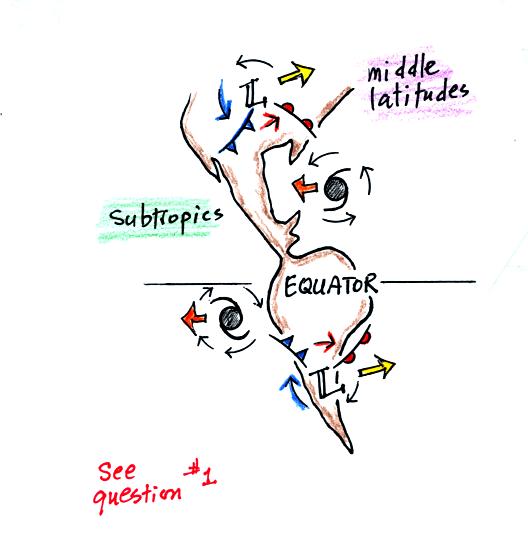
This figure shows the winds spinning around middle latitude
storms
(extratropical cyclones) and hurricanes (tropical cyclones) in both the
northern and southern hemispheres. The term cyclone refers to
winds blowing around low pressure. Note how the directions of the
spinning winds change as you move from one hemisphere to the other.
Note how middle latitude storms tend to move from west to
east in both
hemispheres. Hurricanes, which are found in the subtropics, move
from east to west in both hemispheres. We will learn more about
why this occurs in the next week or so.
Now back
to Newton's 1st and 2nd laws of motion (this is review, we covered this
material last Tuesday)
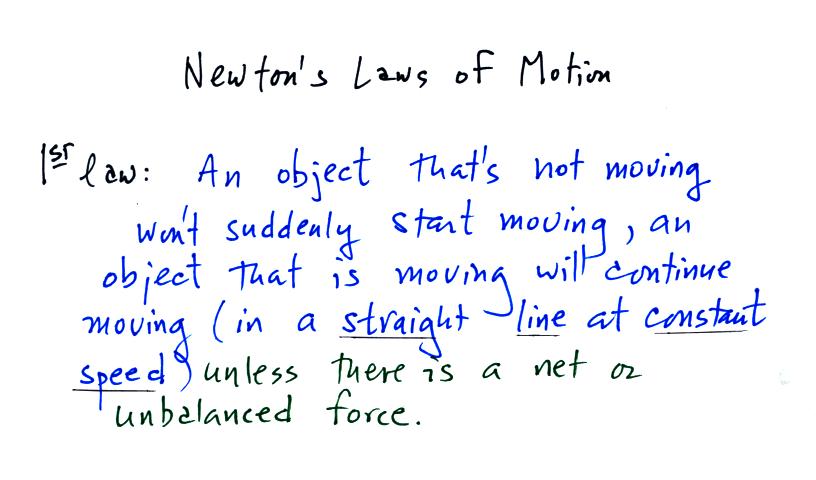
The 1st law really has two parts: one that deals with
stationary
objects and another part that treats moving objects.
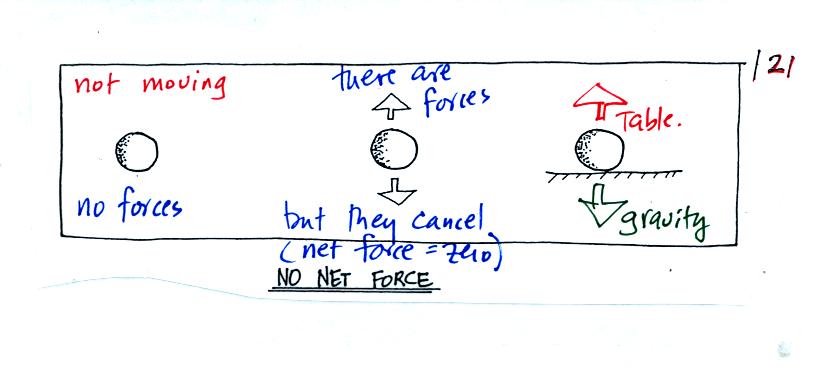
A stationary object is shown in all three figures
above. In
the left example there aren't any forces at all being exerted on the
object, there is no reason for it to suddenly start to move. In
the middle and right examples there are two forces present but they are
of equal strength and point in opposite directions. They cancel
each other out and the net or total force is zero. Again the
stationary object won't suddenly begin to move.
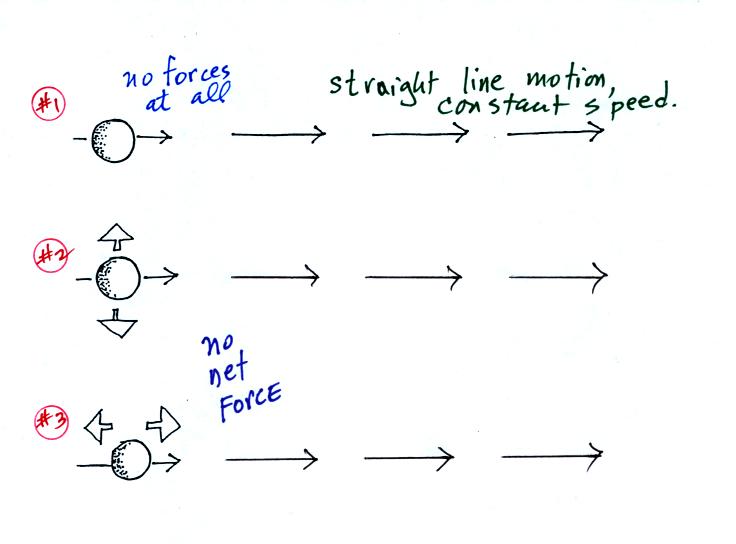
In the first example above there aren't any forces at
all. In Examples #2 & #3 and #4 & #5 below (on p. 121 in
the photocopied notes) the
next force is zero (the two forces present cancel each other
out). The object will continue to move in a
straight line at constant speed (the thin arrows show the direction of
motion, the length of the arrow provides an idea of speed.

We are used to seeing falling objects pick up speed as they
fall. But if an upward drag or friction force becomes strong
enough to balance the downward pull of gravity and the net force is
zero, the object will fall at constant speed. Parachutists take
advantage of this.
By now you should be able to answer
questions 1-6 and 11 on the in-class optional assignment.
Next
we will look at the motion that occurs when a net force is
present. You should be able to look at the motion and determine
whether a net force is needed.
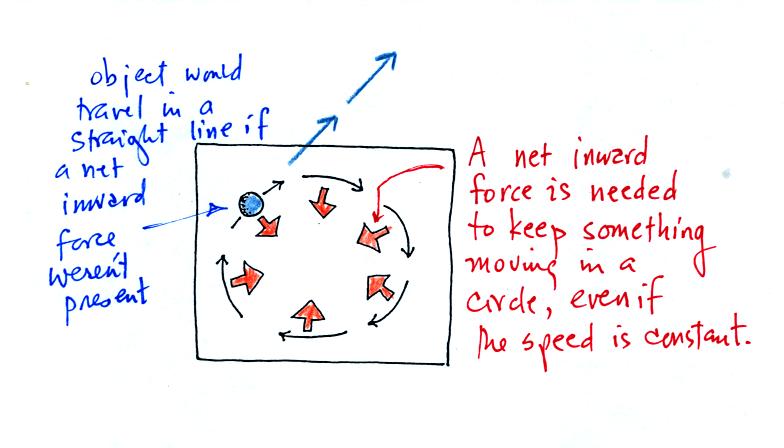
If there were no net force at the point indicated,
Newton's 1st law of
motion would say the object would travel in a straight line at constant
speed (the blue arrows). But the object turns to the
right. A force acting perpendiculary and to the right of the
object's direction of motion are needed. A net inward force is
needed to keep an object moving in a circular path.
An example would be a satellite orbiting the earth
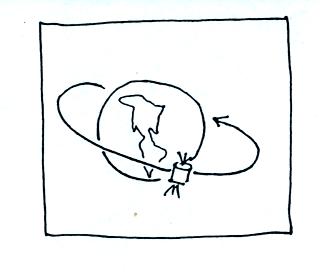
Gravity supplies the net inward force needed to keep the satellite in a
circular orbit.
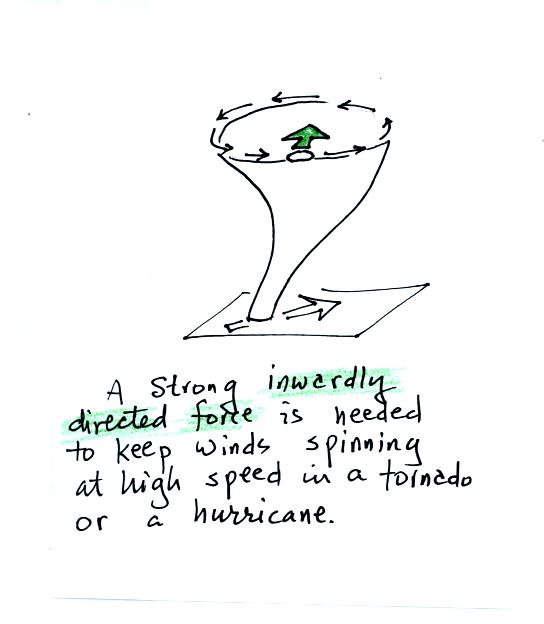
In the case of the rapid winds in a tornado, a very
strong inward force is needed (it turns out to be the pressure gradient
force
(PGF) or pressure difference force).
What we will be most interested in are the upper level winds which, if
you remember from earlier in the semester, blow parallel to the contour
lines on an upper level chart from west to east.
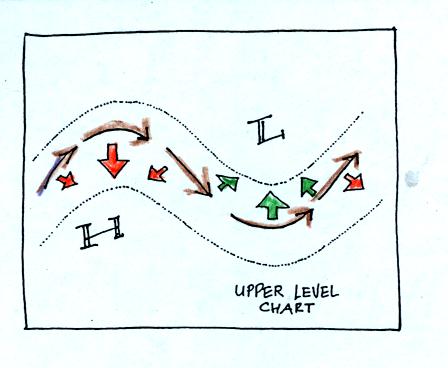
Note that the net force is sometimes to the right of the wind and
sometimes to the left of the wind.
Now
Newton's 2nd law of motion. This is still review from last Tuesday
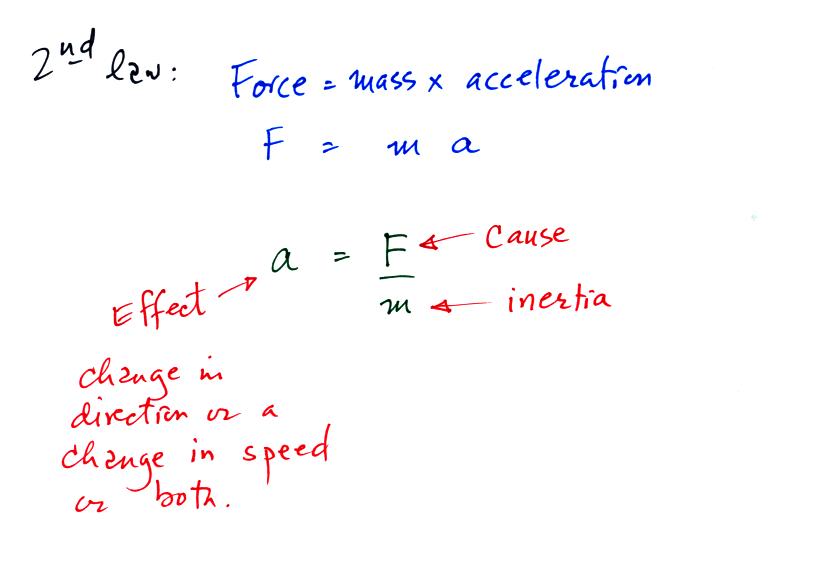
The 2nd law of motion really just says that if you exert a
net force on
an object it will accelerate. Acceleration can mean start moving,
speed up or slow down, start moving in a different direction.
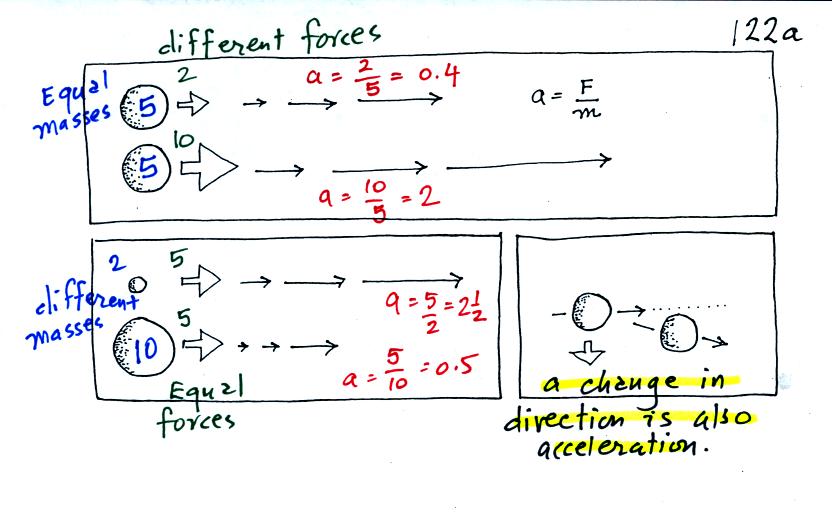
In the first example unequal forces (2 and 5) are applied to
equal
masses (5 and 5), don't worry about the units. You
can calculate the acceleration
by dividing force by mass. This gives you the acceleration, the
lower object will speed up five times faster than the top object which
has a weak force exerted on it.
In the bottom example equal forces (5 and 5) are applied to two
different masses (2 and 10). Mass can be thought as being
inertia, or resistance to change. An object with a large mass is
resistant to a change of
direction or speed. A large object is harder to start moving than
a small object (imagine pushing a stalled Volkswagen and a stalled
Cadillac out of an intersection). The large mass accelerates 5
times more slowly than the smaller mass. Once the large mass gets
up to speed however, is is hard to slow it down (a decrease in speed
with time is a form of acceleration, we usually call it deceleration)
Note that a change in direction, with or without a change in speed, is
also a form of acceleration.

The first two forces above determine upper level winds; we'll study
them first. For surface winds you must include the frictional
force.
That's about where we finished up
before the quiz.
Next we will try to understand what causes these forces. That's
pretty easy with the pressure gradient and frictional force, not so
easy with the Coriolis force. In each case we will learn rules
that determine the direction and the strength of these forces.

Pressure at any level in the atmosphere is determined by the
weight of the air overhead. If you stack up a bunch of bricks as
shown at upper left it is easy to understand that the pressure at the
bottom center of the picture would be higher than an the edges.
Now imagine carrying a bucket of water to the center of a swimming pool
and pouring it out on the water that is already there. You
wouldn't be able to pile up water at the center of the pool. As
soon as you tried the higher pressure at the bottom of the pool would
cause water to flow. The same kind of thing happens with
air. The pressure difference force pushes air from high to low
pressure.
The rules used to determine the direction and strength of the PGF are
given in the center of the picture.
Some examples of PGF force directions and relative strengths
are shown
at the bottom of the figure. Note the analogy between weather
maps and geographical features like hills and valleys.
You have enough information now to answer Question #7
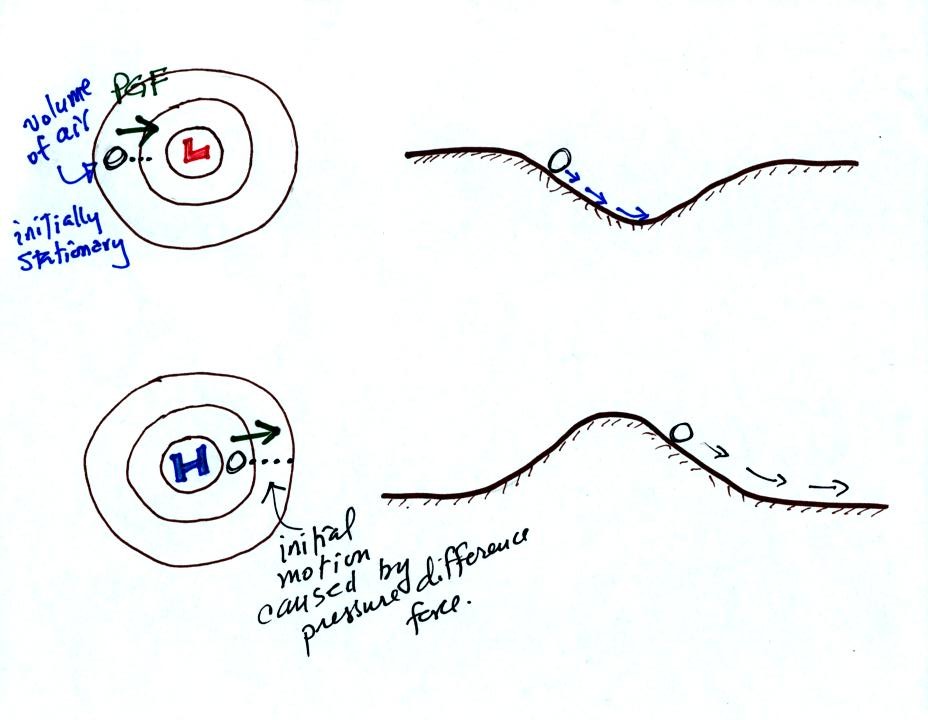
The PGF can cause stationary air to begin to move. In the top
example a stationary volume of air is placed in a center of low
pressure. The PGF will cause the air to begin to move toward low
pressure in the center of the picture. The dotted line shows the
direction of initial motion. This like placing a ball on the side
wall of a valley. The ball will roll downhill.
In the second example, a center of high pressure, the PGF causes a
stationary volume of air to again begin to move toward low pressure
which is outward and away from high pressure. In the analogy a
ball placed on the side of a hill will roll downhill and away from the
summit.
So given a pressure pattern you should be able to determine the
direction of initial motion (see Question #8). Or as in Question
#10 you should be able to determine whether the motion is being caused
by a center of high or low pressure.
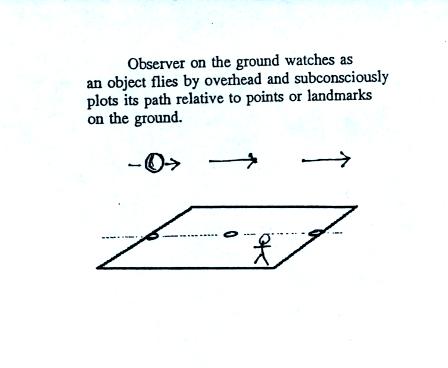
The figure above is from p. 122c in the photocopied
notes.
Imagine that a flying saucer flies over Tucson. It travels
straight from west to east. The next figure shows the path that
the saucer followed as it passed over the city.
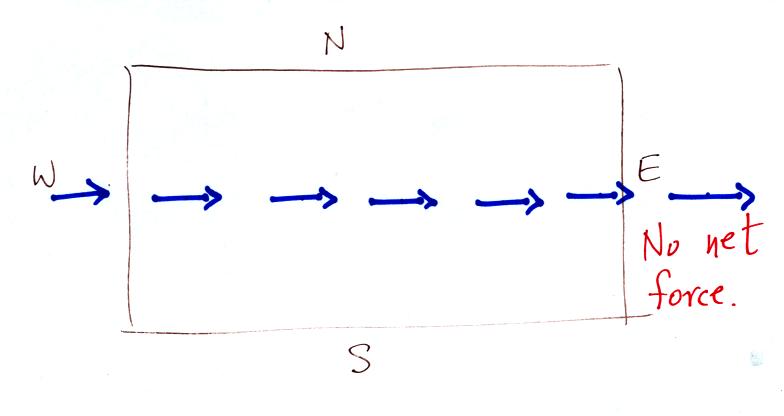
The flying saucer appeared (relative to the ground) to be
moving in a
straight line at constant speed. You would conclude that there
was zero net force acting on the flying saucer.
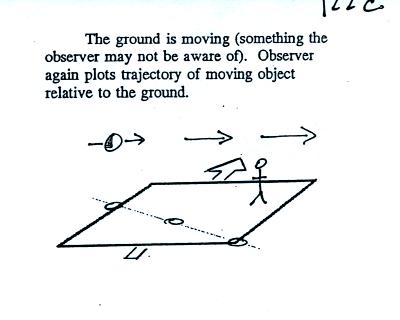
In this second picture the flying saucer flies by overhead
just as it
did in the previous picture. In this picture, however, the ground
is moving (don't worry about what might be causing the ground to move).

This is the path that you would see relative to the ground
in this
case. Even though the flying saucer flew from west to east it
appears to have been traveling from the NW toward the SE because the
ground was moving as the flying saucer passed overhead. Because
the motion is still in a straight line at constant speed, you would
conclude the net force acting on the flying saucer was zero.
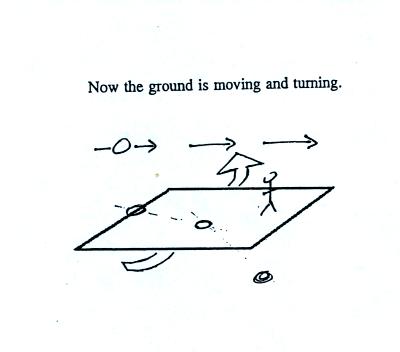
In this last figure the flying saucer flies by again from
west to
east. In this case however the ground is rotating.
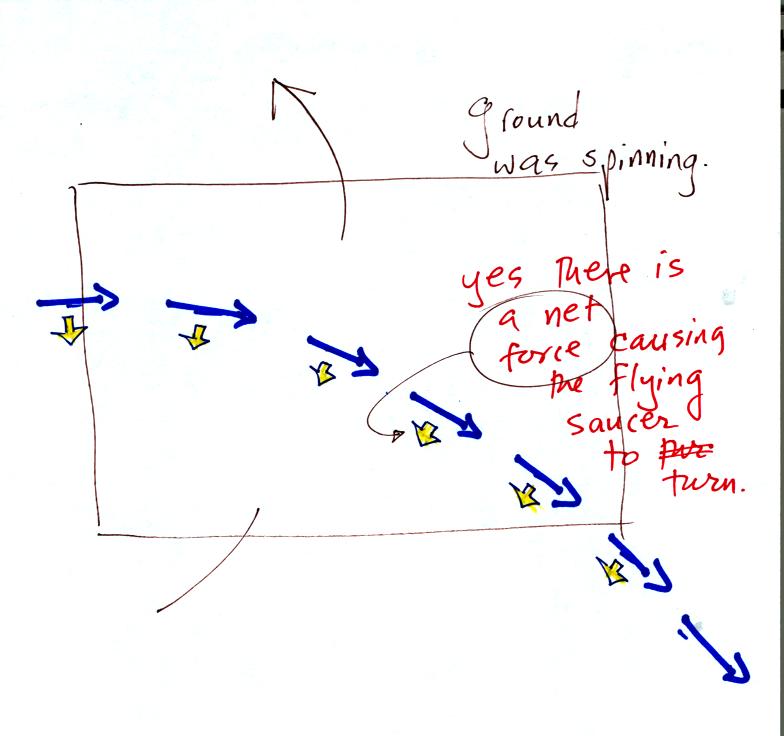
Now the flying saucer appears to have been turning to the
right as it
passed over Tucson. Because it is no longer traveling in a
straight line you would conclude there was a net force acting on the
flying saucer. The direction of this net force would be to the
right of the motion.
At most locations on the earth the ground is rotating. This is
most easily seen at the poles.

Imagine a piece of paper glued to the top of a globe.
As the
globe spins the piece of paper will rotate. A piece of paper
glued to the globe at the equator won't spin, it will flip over.
At points in between the paper would spin and flip, the motion gets
complicated.
The easiest thing for us to do is to ignore the fact that the ground on
which we are standing is rotating. However, if we do that we need
to account for the curved paths that moving objects will take when they
move relative to the earth's surface. That is what the Coriolis
force does.
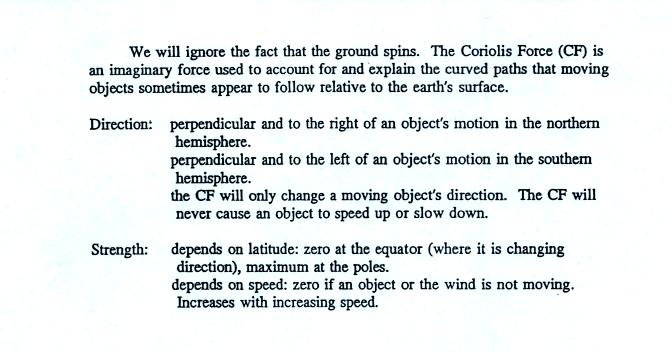
Here are some rules that you can use to determine the
direction and
strength of the Coriolis force. It always points in a direction
that is perpendicular to the wind, it can't cause the wind to speed up
or slow down, it will only change the wind's direction.

The red arrows show the direction of the CF in the northern
and
southern hemispheres. The CF is to the right of the wind (you
need to look in the direction the wind is blowing, you need to look
downstream) in the northern hemisphere and to the left of the wind in
the southern hemisphere.
Now we're
ready to do lots of examples.

Start with the analogous situation at upper left. If you put a
rock on a ramp and let it go, it will roll downhill. If you put
some air in a pressure gradient as shown at upper right. The
pressure gradient force (PGF) will start the air blowing toward low
pressure. The wind will speed up as it goes.
On the larger weather chart at the bottom of the page, we start with a
stationary volume of air at Point 1. The PGF (perpendicular to
the contour lines and pointing toward low) will start the air moving
toward low pressure.
At Point 2 the air is moving and the Coriolis force makes an
appearance. It is perpendicular and to the right of the
wind. It is weak because the wind speed is low. The CF
begins to cause the wind to bend (it is bending to the right if you
look in the direction the wind is blowing).
The wind picks up speed in Points 3 and 4 and continues to bend.
At Point 5, the wind speed is high enough that the CF is able to
balance the PGF. The net force is now zero. From this point
on the winds will blow in a straight line at constant speed parallel to
the contour lines. This is known as a geostropic wind or
geostrophic flow.
Some
similar examples with just the essential details included.
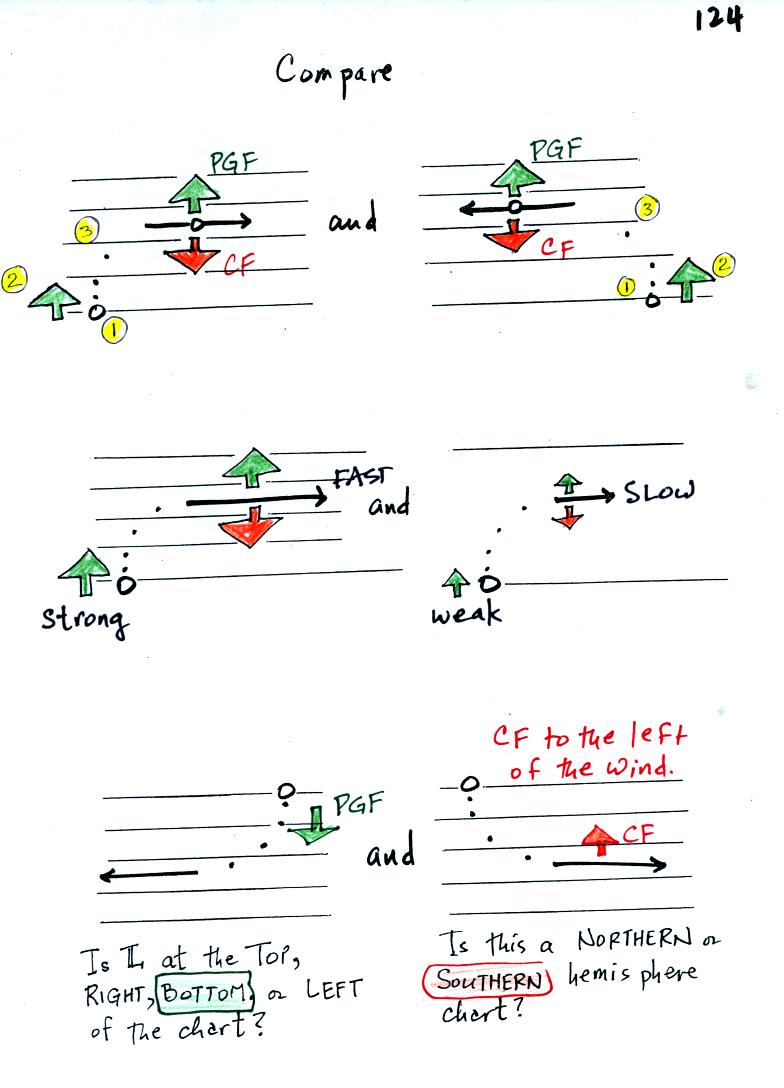
We start with the top left figure. Some air is placed at Point
1. The dots show the direction of the initial motion. The
PGF force starts stationary air moving, so we can identify the force at
Point 2 as the pressure gradient force (low pressure would be found at
the top of this figure. Then if we watch the motion carefully we
see the air beginning to turn to the right at Point 3. This is
caused by the Coriolis force. We know now that this is a northern
hemisphere map. Points 1 and 2 are similar in the top right
figure. But at Point 3 the wind turns to the left. The top
right map is in the southern hemisphere.
The two middle figures show maps with strong and weak pressure
gradients. The wind in the left figure ends up blowing much
faster than the wind in the right figure (much as a rock would roll
quickly down a steep ramp and slowly down a more gradual slope).
The fast wind in the left figure produces a strong Coriolis force
needed to balance the strong PGF. The slow winds at right produce
a weaker CF.
In the bottom left figure the direction of the initial motion (the
dots) is toward the bottom of the figure. The initial motion is
caused by the PGF. The PGF points toward low pressure at the
bottom of the chart. In the bottom right the wind takes a left
turn once it begins to blow (remember you must be looking in the
direction the wind is blowing). That identifies this as a
southern hemisphere chart.
Next we'll
look at upper level charts with circular contour patterns.
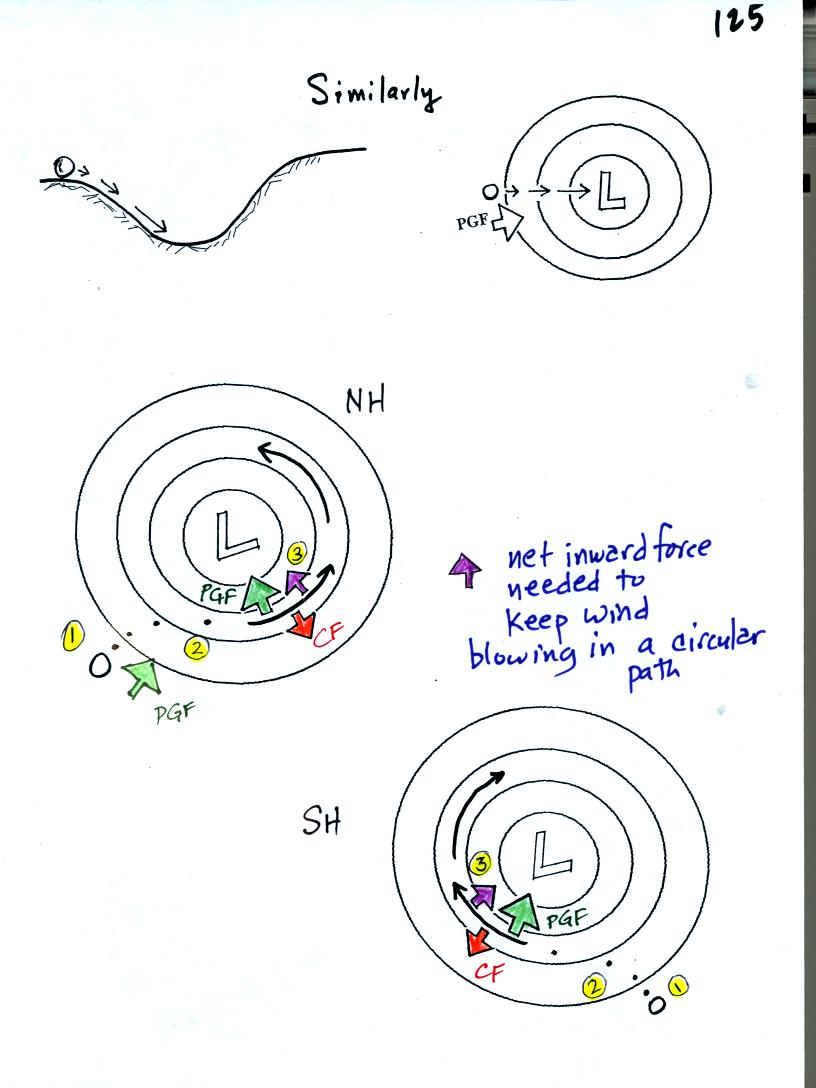
The rock rolling down a hill vs air moving in a pressure
gradient analogy is shown again at the top of the figure.
By now you should be understanding what is shown in Points 1 in the
figure lower figures. The dots tell you the direction of the
initial
motion. They tell you the direction of the PGF, inward toward low
pressure in both these figures. In the middle figure the wind
takes a
right turn at Point 2. This is a northern hemisphere (NH)
chart. The
wind turns to the left at Point 2 in the bottom figure, this is a
southern hemisphere chart.
Note at Point 3 in both charts that the PGF and the CF point in
opposite directions but they are no longer equal in strength. The
inward point PGF is stronger than the outward CF. The difference
provides the net inward force needed to keep the wind blowing in a
circular path.
Because of the Coriolis force, winds blow counterclockwise around low
pressure in the NH and clockwise around low in the SH.

These figures show the wind motions around high pressure centers.
The initial motion is ouward. The CF then bends the wind right or
left depending on hemisphere. A net inward force is present again
in both cases. Winds blow clockwise around high in the NH and
counterclockwise around high in the SH.
Now before
you get the idea that all winds change directions in the NH and SH
we'll look at the next figure.

The winds are blowing from west to east in both hemispheres
even
though the CF changes directions in the NH and SH. How is this
possible. If you look closely you will notice that the pressure
pattern is also "flipped." Low pressure is found at the top of
the map
in the NH and at the bottom of the chart in the SH. The direction
of
the CF changes directions in the NH and SH hemisphere, the PGF also
charnges directions and the winds blow in the same direction.
If you look closely at the figure you will notice that the CF force is
sometimes stronger (left side) and sometimes weaker (right side) than
the PGF. This changing imbalance is needed for the right and left
turns that the winds take as they blow through this pattern. If
you
remember that the strength of the CF depends on latitude (as well as
wind speed) you can understand why the CF changes strength. The
CF is
strongest when the winds are far from the equator (left side), weakest
when the winds are close to the equator (right side).
If you
ever go to the southern hemisphere one of the first things you might
do, once you land, is to rush into the airport bathroom and flush the
toilet or drain a sink. You would do this because you might
remember having heard that as the water drains it spins in the opposite
directions in the northern and southern hemispheres. It is an
interesting story but unfortunately it isn't true (don't worry there
are still plenty of other interesting things to do in the southern
hemisphere).
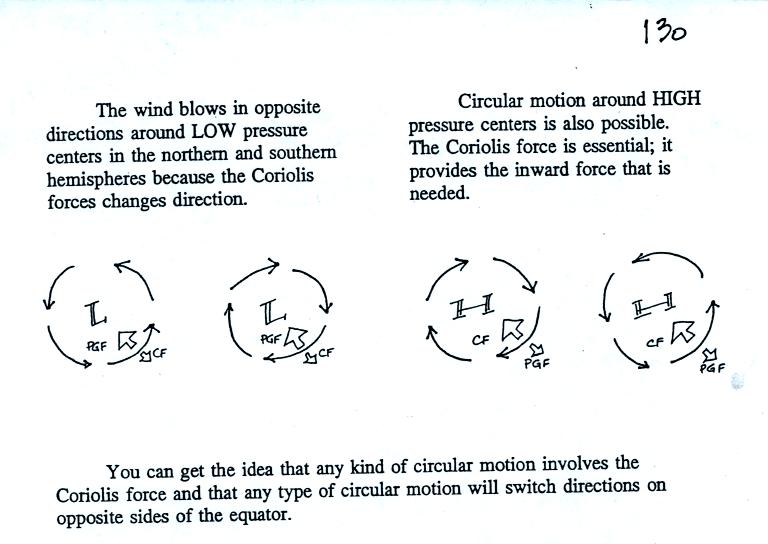
Spinning motions do change directions when the Coriolis force is
involved.

In some cases such as water draining from a sink or winds in
a
tornado, the PGF is much stronger than the CF and the CF can be
ignored. In this case the winds or water can spin in either
direction
in either hemisphere.






























